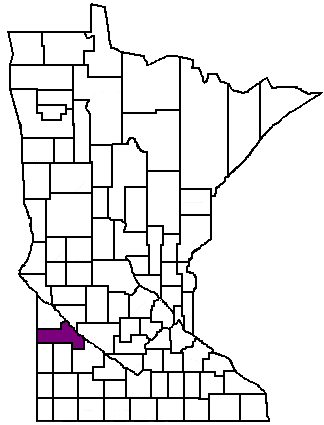



| Home | History | Links | Lookups | MN GenWeb |
| Photos | Queries | Surnames | Townships | What's New |
"Pejihutazizi" is the Dakota term for "Yellow Medicine," the moon seed plant, for whom the river and the county were named.
The area which now composes Yellow Medicine county became a part of Minnesota Territory in 1849 with the creation of that territory following the statehood of Iowa and Wisconsin. The whole Mississippi valley was part of the Louisiana Purchase, received from France in 1803. The division of the Purchase into territories and states had been proceeding for half a century when the northern area was down to Minnesota Territory, which also included the Dakotas.
Yellow Medicine county as it is known today, lay below the east-west county line dividing Dahkotah and Waubashaw, two of the nine counties in the territory. Four years later, in 1853, the old counties were re-formed and Blue Earth county came into being, with the future Yellow Medicine county lying somewhere in this vast stretch of land extending westward into the Dakotas. Brown county was hatched out of Blue Earth in 1855, including everything in Minnesota south of the Minnesota river, and extending from Blue Earth county west into the Dakotas.
Statehood brought rapid settlement of Minnesota and the frontier moved westward. In anticipation of jurisdictional problems in the wake of the Sioux Uprising when thousands of white settlers streamed into the old reservation lands, the state legislature in 1865 thought it best to divide Brown county and create a new one - Redwood county. This new county included land from Brown county westward to the Dakota line, comprising the present counties of Lyon, Lincoln, Yellow Medicine and Lac Qui Parle as well as Redwood.
Source - History of the Minnesota Valley, including the Explorers and pioneers of Minnesota
North Star Publishing Company, Minneapolis - 1882.
Yellow Medicine County entered into existence with the first meeting of county commissioners (John Winter, Ole O. Lende, and Leonard Hazelden) on January 1, 1872 in Yellow Medicine City. The new county had no county seat but there were three fledgling villages - Minnesota Falls, Granite Falls, and Yellow Medicine City - vying for the seat. At a board meeting on January 27, 1872, Yellow Medicine City was chosen as the county seat. Plans were made to build a courthouse, but by the spring of 1873 no building had been erected yet.
In the winter of 1873, Henry Hill, proprietor of the Granite Falls townsite revealed his plan to introduce a bill in the legislature for the removal of the county seat from Yellow Medicine City to Granite Falls. He also agreed to donate a courthouse site. A stock company was organized to finance the construction and the necessary labor was donated. Before the spring of 1874, a building housing a courtroom and three small offices was completed on the site of the present sheriff's office building.
The bill to move the county seat from Yellow Medicine City to Granite Falls passed the legislature in February and was signed by governor C. K. Davis on March 9, 1874. But the battle was not over. The last hurdle required the approval of the county electorate. Yellow Medicine City contested the election and requested a restraining order. The case was tried before Judge M. G. Hanscome who found in favor of Granite Falls.
While this action was pending, more direct action was taken. A group of seven men riding a lumber wagon behind the fastest team they could find, headed for Yellow Medicine City one winter night. Before reaching their destination a halt was made, and sacks were wrapped around the steel tired wagon wheels to muffle their squeaking on the frozen ground. The men blackened their faces with burnt cork.
Stopping on the side of a hill near the building used for a court house, six men stole toward the building leaving one in charge of the team. They broke into the ramshackle structure and searched the offices, finding a scant dozen record books, a few files, some stationery and forms. These were carefully loaded into the wagon and covered, and a retreat was made. As it began to snow, the group left as silently as they had entered.
The party got back to Granite Falls about three o'clock in the morning. The next day three of the party wrapped the records carefully and took them out to Stony Run where they were hidden in a haystack.
Officers with search warrants hunted through many Granite Falls homes, but found no trace of the missing records. But when the court's decision favoring Granite Falls' bid for the county seat was handed down, the records mysteriously turned up in the new court house. Perhaps no secret was ever kept better than that of the identity of the court house burglars.
The state legislature of 1885 set down a method and manner of moving a county seat. All it took was a petition to the county board signed by a majority of the county's freeholders, legal voters and residents asking for the question to be put to a vote and the next general election. If approved by the majority, the county seat could be moved. If the proposal failed, it could not be brought up again for five years.
 Clarkfield, a little town in the center of the county, presented a petition with 761 signatures to the county board on March 26, 1886 asking that Clarkfield be designated as the county seat. The original petition was denied because it lacked clarity in form. Again it was petitioned, but was defeated this time for lack of required signatures.
Clarkfield, a little town in the center of the county, presented a petition with 761 signatures to the county board on March 26, 1886 asking that Clarkfield be designated as the county seat. The original petition was denied because it lacked clarity in form. Again it was petitioned, but was defeated this time for lack of required signatures.
Due to these efforts which threatened to move the county seat, Granite Falls businessmen were determined to replace the modest frame building with something more substantial. In 1888 they offered the county $5,000 toward the erection of a new court house providing that the county would erect the building at a cost of not less than $12,000 and have it done by December 1, 1889. The board voted favorably and awarded the bid of $14,769 to a Minneapolis firm. The cornerstone of the new courthouse was laid July 4 and the building was completed November 23, 1889. The old courthouse was sold for $200 and was eventually moved.
In 1940, Clarkfield again tried to have the county seat moved. A petition carrying 5,778 signatures was filed at the courthouse. The petition was accepted and February 10, 1941 was set as the election date. Strong voter turnout was demonstrated. The number of votes cast was 8,538, of which Clarkfield needed 4,695. They received only 3,269 while Granite Falls received 5,269.

Last Updated: